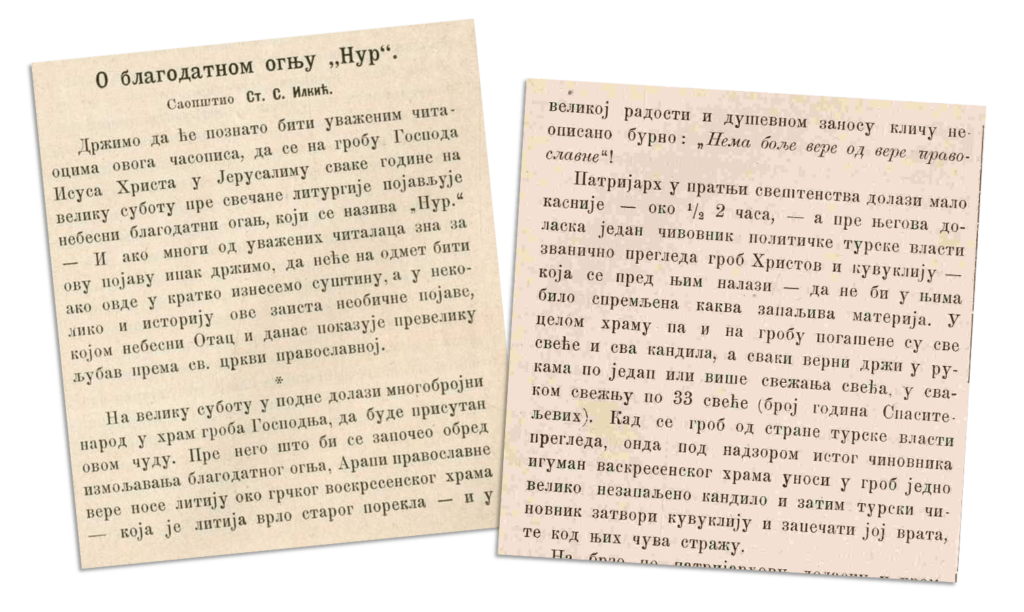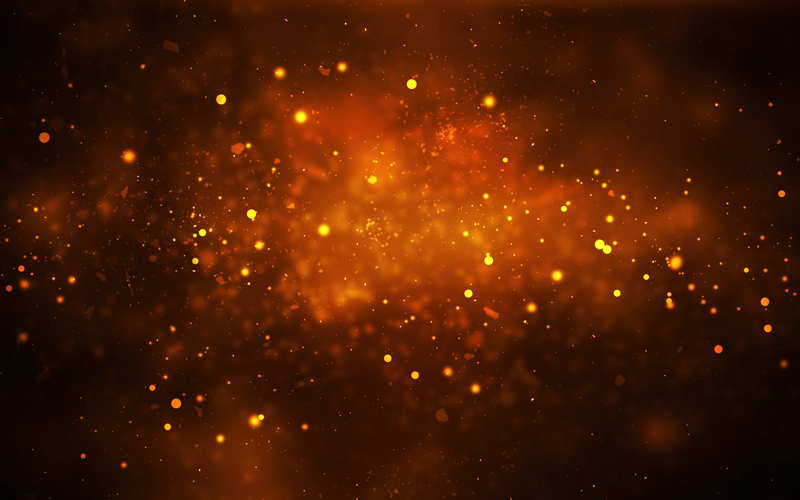Original article (in Serbian) was published on 17/6/2024; Author: Stefan Janjić
Dimitris Alikakos ended up in court because of a 144-page booklet and a 25-minute interview.
In 2019, this Greek journalist presented evidence that the “Holy Fire” in the Church of the Resurrection of Christ in Jerusalem does not light up by itself on Holy Saturday, but that the “miracle” happens with discreet assistance. He received this confirmation in the most direct way possible, first-hand – the hand that lights the flame: Archbishop Isidore from the Patriarchate of Jerusalem unequivocally confirmed to him that there is no miracle in the ceremony.
Reader: The sky perhaps sent a blessing, but not the flame
We started investigating this topic after a reader sent us an excerpt from the news of the Tanjug agency from May 4, which was then reported by many media:
“The holy fire came down to the Temple of the Resurrection of Christ in Jerusalem. The Patriarch of Jerusalem Theophilus III came out of the aedicule where he prayed for the fire to enter and began to distribute it to the believers gathered in the temple. The miracle of the holy fire takes place on the eve of Christ’s resurrection according to the Julian calendar, in the church that was built over the place where Jesus Christ was crucified, buried and resurrected…”
In the accompanying commentary, the reader states that a flame could not descend from the sky, but possibly a blessing. “Neither the believers nor the Church make any effort to reveal to the public that there is no miracle of lighting the flame, probably because it is not worth it, despite the fact that Jesus is the way, the TRUTH and the life… But that is why the media must publish only verified information and be careful not to spread disinformation”, writes our reader who also sendt links to the video authored by Dimitris Alikakos.
FakeNews Tragac tried in the previous weeks to get the comments of several people on this topic but without success. For this reason, we will present the conclusions that can be reached based on the sources of the Serbian Orthodox Church, the Patriarchate of Jerusalem, archival materials, and Dimitris Alikakos’ video.
How does a “miracle” happen?
Let’s start from the very beginning. If we are guided by the information from the website of the Serbian Orthodox Church (“Srpska Pravoslavna Crkva – SPC”), the miracle of the holy fire takes place in the temple of the Holy Sepulcher (or the temple of the Resurrection of Christ) in Jerusalem from the year 335 until today.
According to the explanation of the SPC, on Holy Saturday, the patriarch enters a small stone chapel in the center of the temple, also called kuvuklia, kneels before Christ’s tomb and prays, and then the “fire thread” miraculously lights the lamp. The flame is transferred to the candles that the patriarch brought with him, and then – from candle to candle – it spreads among the gathered believers.
“Okay”, a sceptic would say, “but what if it’s the patriarch who lights the flame?”
“That’s impossible”, a believer familiar with the complex procedure of this ritual would answer him: “The commission, which includes representatives of the police, the city authorities of Jerusalem, as well as representatives of the Turks, Orthodox Greeks, Armenians and Copts, controls whether there is anything that could be used to light the fire”.
Centuries of mistrust
If we shake off the virtual dust from the digitized archives, we will find a 127-year-old text about the holy fire in the magazine called “Srpski sion”. In the text, a lot of attention was also paid to the description of the control procedure that the patriarch must go through in order to reach the place of resurrection on Holy Saturday: “The patriarch, accompanied by the clergy, comes with a lithia in front of the kuvuklia, removes a part of the church vestment, and the Turkish clerk politely examines him to make sure he is not carrying any inflammable substances, and accordingly unlocks the door and lets the patriarch in.”

Let’s pay attention to the word “politely”: if you want to determine whether someone is hiding a box of matches or (nowadays) a lighter under several layers of clothing, how thoroughly would you have to examine them? A sufficiently detailed examination would be undignified, so it can be said that this is more of a protocol than a fundamental examination because it is understood that the patriarch does not intend to perform a magic trick, but rather to pray.
In 1897, “Srpski sion” states that “only the Romans (Roman Catholics) resolutely deny the truth of the holy fire”, and that all Roman Catholic travel writers “publicly trumpet that it is only a deception of the people by the Orthodox Greeks and that the holy fire sent from the sky doesn’t appear on the grave of the Lord but it must be produced by an Arab who was previously hidden in a grave”. The motive of the Roman Catholics to deny the miracle in this way originates – claims “Srpski sion” – “from the hatred that the holy fire is directly received by the Orthodox and not the Roman Church”.
Practical and religious aspects of the dispute
Those who contested the miracle of the holy fire in previous centuries were not only from the ranks of Roman Catholics, nor were they focused exclusively on the practical aspects of the ritual (hidden matches, hidden Arab)
Nikolai Uspensky (1900-1987), professor of liturgy at the Leningrad Theological Academy, argued that it would be presumptuous to expect God to confirm his presence every year in the same place, on a certain day, hour and minute. Uspensky referred to the previous records of Bishop Porfiri (1804-1885), in which it is also stated, based on the testimonies, that the flame does not arise by itself, but originates from a previously lit candle.
Greek journalist Alikakos heard the same thing from his father, an Orthodox priest: yes, God works miracles, but the appearance of the holy fire is not one of them, but the work of human hands. Alikakos went to Jerusalem in 2018, with the intention of establishing the truth.
Confession of Archbishop Isidore
Archbishop Isidore was born in 1973 in central Greece and arrived in Jerusalem in 1986. In the Church of the Resurrection, he served as a monk, then a deacon, before becoming an archimandrite in 1996, and an archbishop in 2013. He was appointed guardian of Christ’s grave in 2005.
The interview with the archbishop was conducted in Greek, lasts about 25 minutes and was posted on the YouTube channel “Holy Fire – The Truth”.
After eight minutes, Isidore informs Alikakos that he is the one who brings the lamp into the grave. “And what happens then?”, asks the journalist. Isidore laughs and answers that he doesn’t know if he should say that in front of the camera – his words could hurt the religious feelings of many.
“Do you think the truth offends or elevates religious feelings?” Alikakos asks. After a short hesitation from the interlocutor, the journalist quotes Christ’s words from the Gospel of John: “You will know the truth, and the truth will set you free”.
We come – then – to the truth: Isidore is the one who lights the flame of the lamp, or rather the first of the two lamps. The “secret” of the holy fire was communicated to him in 2000, although he claims that it was more a confirmation of what he himself assumed. When asked: “Can we say that the way the flame is created is a miracle?”, Isidore answers: “No, of course it is not a miracle”.
On the same channel, we also find a video of the ceremony. The patriarch enters Christ’s tomb, where supposedly there shouldn’t be any flammable substances, and yet – despite the large crowd and the unstable video – we can see the flames, which Alikakos claims originate from the previously brought oil lamp. Then, in the continuation, we see the scene of the grave after a lighted lamp is taken out: there is another one on the grave.
Lawsuit and judgment
Based on the collected testimonies, Alikakos published the book “Redemption – The Case of the Holy Fire”, and made the video materials publicly available on the aforementioned YouTube channel.
In March 2019, the Jerusalem Patriarchate addressed the public via Facebook, stating that the videos were created illegally, without the knowledge of its interlocutors. Nevertheless, it is quite clear that Archbishop Isidore was aware of the camera being turned on, because he was looking at it, and even wondered aloud if he should say something “in front of the camera”. The Patriarchate claimed that Alikakos was pretending to be a tourist and that he used montage to draw the desired conclusions. Also, the Patriarchate claimed everything he made public was a fabrication and asked Google to remove the controversial videos from the Internet.
A lawsuit filed by the Jerusalem Patriarchate in an Athens court was dismissed this spring, and the footage is still online.
Despite direct evidence suggesting that the creation of the flame is not miraculous, many believers maintain their faith in the miracle, particularly those who were present in Jerusalem on Holy Saturday. Some witnesses assert that their candles lit spontaneously, while others claim they could bring the flame very close to clothing and skin without causing harm. This is evident in the comments below the interview with the archbishop.



